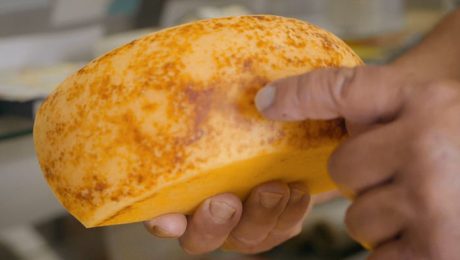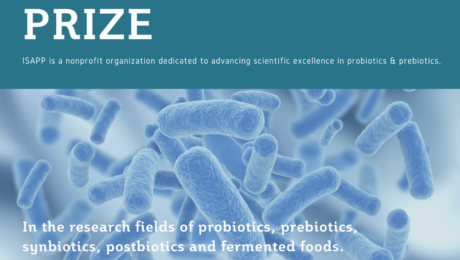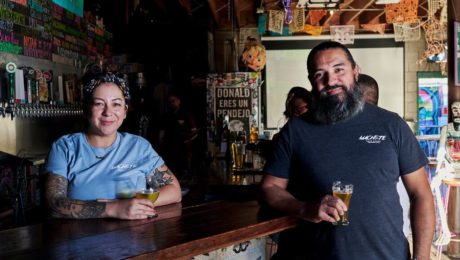FERMENTATION 2021 Wrap-Up
Nearly 300 individuals from around the world participated in The Fermentation Association’s first conference, FERMENTATION 2021. The virtual event included 35 educational keynotes, presentations, and panel discussions from more than 60 speakers over three days. Topics ranged from the science of fermentation to the art of fermenting to create flavor, from how fermented products are selling at retail to what’s next in the world of fermentation.
“I’ve been in this field for 40 years and, in all honesty, this is one of the biggest honors I’ve received, to be the speaker for this opening meeting of this really cool organization,” said Bob Hutkins, professor of food science at the University of Nebraska. Hutkins presented the conference’s opening keynote, Definition & History of Fermented Foods.
Over five years ago, John Gray, TFA’s founder, envisioned a trade show for producers of fermented foods and beverages, to make those artisanal items a more prominent part of the retail space. John connected with Neal Vitale, TFA Executive Director, and the organization was born out of their collective vision. TFA has grown, with a robust website, biweekly newsletter,a series of webinars and, now, an international conference. TFA has an Advisory Board that includes food and beverage producers, academics and researchers, and food and flavor educators and authors. TFA has formed working relationships with a number of other like-minded trade associations and organizations, and established a Buyers Council to create an active dialogue with food and beverage distributors, brokers and retailers.
“I have to tell you what a thrill it is to have you all here to witness and to participate in the beginning of a dream coming true,” added Gray in his welcoming remarks. Gray is the chairman and CEO of Katalina Holding Co., a food incubator and parent company of Bubbies Pickles.
FERMENTATION 2021 content paralleled TFA’s primary missions: first, help consumers better understand fermentation and its potential health benefits; second, work to improve health and safety regulations as they pertain to fermented products and third, connect the science and health research communities with producers, supporting scientific research and for a better understanding of the “state of the art.”
What made FERMENTATION 2021 unique is that it was the first event to bring together everyone involved in the world of fermentation — producers, retailers, chefs, scientists, authors, suppliers and regulators. The conference was not a how-to fermentation education event, as TFA feels there are numerous, effective resources for the person looking to, for example, make kimchi or learn about using koji.
“”We were delighted with how well FERMENTATION 2021 met — in fact, exceeded — our goals,” said Vitale. “While we were disappointed that the continuing impact of COVID-19 kept us from meeting in person, we were gratified by how all the participants responded, interacted, and engaged during our three jam-packed days. And, with recording of all our sessions now available online for our registrants, we expect that energy and excitement to continue.”,
“Fermentation is experiencing a major surge of interest in restaurants and kitchens around the globe,” says Amelia Nielson-Stowell, TFA Editor. “Our conference was a major milestone for the industry and we are already in the planning stages for FERMENTATION 2022 next summer. And, assuming we will be able to meet in person once again, we plan to host a tasting and sampling event for consumers alongside our conference.”
- Published in Business, Food & Flavor, Health, Science
Food Technology’s “Gut Feeling”
Food Technology’s latest issue features an article entitled “Not Just A Gut Feeling” which details how and why more consumers are buying and making fermented foods and drinks. Spurred by the Covid-19 pandemic, there is growing interest in the gut microbiome and healthier food options.The curiosity around fermentation is buoying the retail category.
“It checks off all the boxes — artisanal, local, natural, sustainable, innovative,” says Bob Hutkins, food science professor of food science at the University of Nebraska–Lincoln (and a recent addition to TFA’s Advisory Board.) “People are making sourdoughs at home; they’re making kimchi at home; they’re going to kombucha bars. It’s definitely got the Gen Xers and the millennials intrigued.”
Included in the article are many insights from TFA — Advisory Board members Alex Lewin and Kheedim Oh, Executive Director Neal Vitale, and Editor Amelia Nielson-Stowell are all quoted.
Read more (Food Technology Magazine)
- Published in Business, Food & Flavor
The Next Frontier in Kitchen Appliances
Is fermentation the next big home kitchen technique? As more restaurants hire directors of fermentation, consumers are inspired to experiment at home.
An article in The Spoon makes a case for the rise of home fermentation equipment, which makes the process “a little less mysterious.”
“Fermenting is still viewed as something of a black art. Part of it is the weird and slightly creepy terminology (mother, anyone?). Mostly, though, it’s also because the act of farming bacteria to create tasty and healthy new foods is a far cry from the usual activity of assembling and cooking our meals in our kitchen.”
The article interviewed two entrepreneurs making their own fermentation devices: Breadwinner (which helps bakers know when their sourdough starter is ready) and Hakko Bako (a fermentation appliance). The creators say their products are making fermentation easy, controlled and approachable. Tommy Cheung of Hakko Bako notes food trends usually start in Michelin restaurants, then trickle down to casual dining and finally end up at the home kitchen. “I definitely think (home fermentation devices) are going to be a huge part of the future.”
Read more (The Spoon)
- Published in Business
Fermenting Coffee with Koji?
A two-time Finnish Barista Champion made headlines with his unique cup of joe at the World Barista Championship in Italy — a koji-fermented coffee.
Aiming to make better coffee than what’s available on the market, Kaapo Paavolainen (pictured) studied how he could maximize the flavor in coffee beans. “Sugar in beans is responsible for coffee’s inherent sweetness but the lack of it results in unpleasant bitterness. But the current methods can extract only 70% of available sugar,” he told Forbes.
After reading about koji in the books Koji Alchemy (by Jeremy Umansky and Rich Shih) and The Noma Guide to Fermentation (by Rene Redzepi and David Zilber), he realized koji can tap into the remaining 30% of sugar in beans.
Incredibly, this koji-based method was used on subpar coffee beans in experiments and still transformed the coffee. Umansky described the flavor as “deep, earthy and leathery. Depending on the roasting level of the beans, the flavor ranged widely from tropical fruits like pineapple and mango to chocolate and gingerbread. The mouthfeel was strikingly silky and luxurious like butter. The rounded, full-bodied texture made these tastes last very long.”
Paavolainen aims to scale the koji process with a partner farm in Columbia. This new coffee method could aid coffee farmers, many of whom are financially challenged and are struggling to maintain farms in the face of climate change.
Read more (Forbes)
- Published in Business, Food & Flavor
The São Jorge Cheese
On the remote, volcanic island of São Jorge in the middle of the Atlantic is what Insider calls “Portugal’s best-kept secret” — its eponymous cheese.
The weather conditions on the island make it perfect for cheesemaking, an art that began there 500 years ago. It’s humid, so cheese can rest at room temperature, packing the cheese with moisture. Cows (there are over 10,000 on the island, double the number of the human inhabitants) can graze year round.
São Jorge cheese is rich, with “hints of spiciness, and a grassy scent.” One of four dairy farmers on the island, João, ascribes the flavor to the cheesemaking process, which preserves “the flavors of the island in the cheese by not killing the native cultures that are present in the milk.” The milk is kept raw, unpasteurized and whey from the day before is used to ferment the milk instead of adding fermenting agents.
Read more (Insider)
- Published in Food & Flavor
The Brewing Coffee-Farming Crisis
Many pressures are building on coffee farmers, making their jobs increasingly difficult. Climate change is causing numerous impacts — temperatures are rising, rainfall is increasingly unpredictable, weather can swing from drought to flood, and new crop pests are emerging. And these problems are on top of existing environmental concerns, as growing coffee requires large amounts of water.
Further, studies show that, even with “modest declines of greenhouse gas emissions, about 50 percent of the land with conditions suitable for growing the two main species of coffee, arabica and robusta, which account for 99 percent of commercial supply, ‘could disappear by 2050.’ Brazil and Vietnam, major producing countries, would be especially hard hit.”
The Times details several organizations’ efforts to aid coffee farmers by restoring and protecting water resources, supporting more efficient use of water, improving crop yields with targeted fertilization and starting a global breeding network for new coffee species that can withstand tough climates.
Read more (The New York Times)
Glenn Gibson Early Career Researcher Prize
Applications are being accepted for the 2022 Glenn Gibson Early Career Researcher Prize, sponsored by the International Scientific Association for Probiotics and Prebiotics (ISAPP). The winner will receive $1,500 U.S. cash and an invitation to present at the 2022 ISAPP annual meeting. Click here for application details, due Nov. 19.
In 2021, ISAPP launched the Early Career Researcher Prize. As this initiative was spearheaded by ISAPP co-founder and longtime board member Prof. Glenn Gibson, this award was renamed to honor him: “Glenn Gibson Early Career Researcher Prize”. The intent of this award is to recognize excellence in research in early career researchers in the fields of probiotics, prebiotics, synbiotics, postbiotics or fermented foods.
- Published in Science
“A modern-day Johnny Appleseed”
GQ interviews “The Godfather of the Fermentation Revival,” Sandor Katz. In the Q&A, Katz shares how a cabbage surplus in his first garden turned into an obsession with fermentation. Katz teaches fermentation workshops and gives fermentation talks around the world (he will be speaking at FERMENTATION 2021). He’s also now the author of six books on fermentation, including the recently-published Fermentation Journeys.
The article says Katz “has become a globe-trotting mascot for the power of bacteria and yeast to create delicious food, a kind of modern-day Johnny Appleseed of tangy, savory flavors.”
Katz shares how he’s interested in learning more about the Chinese techniques for fermenting vegetables; he believes China is where fermenting vegetables in salt first originated. He also addresses his misquoted healing. Katz has lived with H.I.V for more than 30 years, but he says eating fermented foods does not cure AIDS. Katz does believe he’s never been sick from the antiretroviral drugs he takes to manage the disease because he eats fermented foods regularly.
Read more (GQ)
- Published in Food & Flavor
Are Beer Bars Dying?
As the number of craft breweries continues to balloon — growing to nearly 9,000 in 2020 — craft beer bars are going extinct. The New York Times explores why: brewers are turning into competitors. Few people want to drink at a bar when they can instead go to a brewery’s own taproom.
Bars helped the craft industry grow, but now what was once “a prime way of bringing people into bars was gradually taken away by the breweries themselves,” says Chris Black of Falling Rock Tap House in downtown Denver. Black was forced to close his bar this summer, as the COVID-19 pandemic caused sales to plummet.
The pandemic accelerated closures for numerous failing bars across America, a big loss for locals who found community at their hometown establishment. But brewery taprooms aren’t the only culprit. The article notes craft beer used to be found only in bars — now it can be purchased in stadiums and supermarkets.
(Pictured: Joann Cornejo and Eddie Trejo, who run Machete Beer House in National City, Calif. It’s a community-focused bar that offers brews from America and Mexico and features pop-up vendors selling birria tacos and paletas.)
Read more (The New York Times)
- Published in Business










